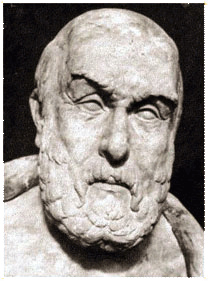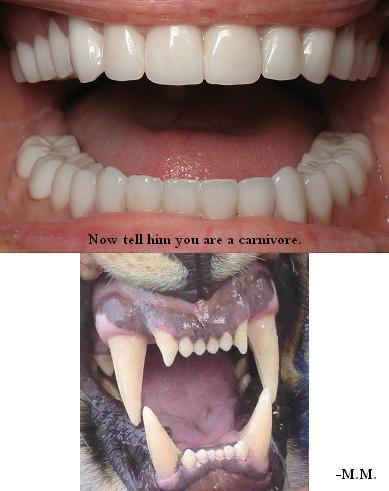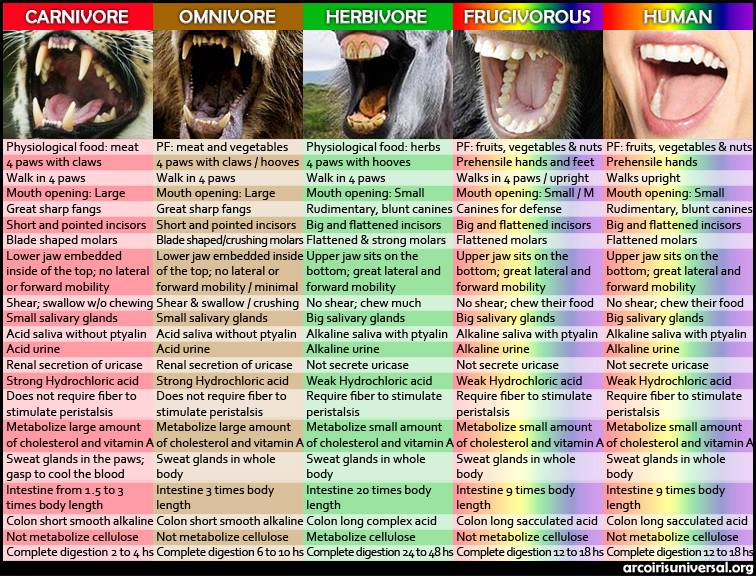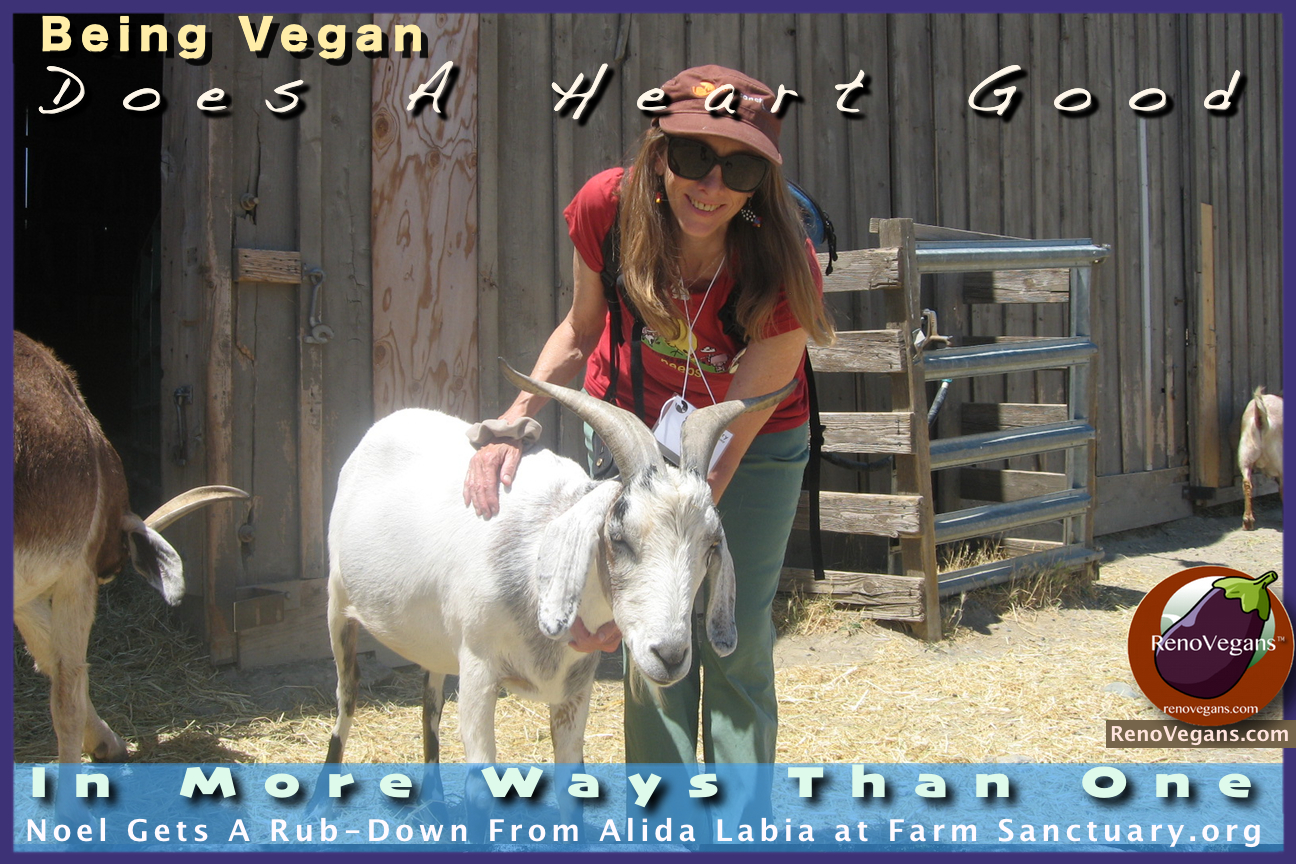 Reasons to Go Vegan #2: Physiology
Reasons to Go Vegan #2: Physiology
 Physiology
Physiology
 "Animals are my friends… and I don't eat my friends."
"Animals are my friends… and I don't eat my friends."
—George Bernard Shaw
 The soul is the same in all living creatures, although the body of each is different.
The soul is the same in all living creatures, although the body of each is different.
—Hippocrates
Are Humans Carnivores or Herbivores?
 Carnivores have claws, sharp front teeth capable of subduing prey, and no flat molars for chewing. Herbivores have no claws or sharp front teeth capable of subduing prey, but they have flat molars for chewing. Humans have the same characteristics as herbivores.
Carnivores have claws, sharp front teeth capable of subduing prey, and no flat molars for chewing. Herbivores have no claws or sharp front teeth capable of subduing prey, but they have flat molars for chewing. Humans have the same characteristics as herbivores.
But aren't humans anatomically suited to be omnivores?
Nope. We don't anatomically match up with omnivorous animals anymore than we do with carnivorous ones. Omnivores are more similar to carnivores than they are to herbivores. For a more detailed summary table that compares the properties of carnivores, herbivores, and omnivores side by side, see This table of food-eating types which concludes, "Science provides us with an indicator of human nutrition which was not established by culture, but is certainly that of a herbivore or frugivore and not a carnivore or omnivore."
More at Steven Pavlina.com…
Vegetarian Food and The Gastro-Intestinal Tract
That man is a vegetarian animal is amply exemplified by his basic anatomy. Unlike carnivorous animals, man has teeth suited for biting and grinding and not for tearing. The intestines of man are longer as compared to their carnivorous counterparts. These are but the most basic of differences that exist between vegetarian and non-vegetarian 'animals'.
Humans vs. Carnivores
Start at 00:35 to skip the inexplicably hokey opening.
Articles
 Carnivores have claws, sharp front teeth capable of subduing prey, and no flat molars for chewing. Herbivores have no claws or sharp front teeth capable of subduing prey, but they have flat molars for chewing. Humans have the same characteristics as herbivores.
Carnivores have claws, sharp front teeth capable of subduing prey, and no flat molars for chewing. Herbivores have no claws or sharp front teeth capable of subduing prey, but they have flat molars for chewing. Humans have the same characteristics as herbivores.
But aren't humans anatomically suited to be omnivores?
Nope. We don't anatomically match up with omnivorous animals anymore than we do with carnivorous ones. Omnivores are more similar to carnivores than they are to herbivores. For a more detailed summary table that compares the properties of carnivores, herbivores, and omnivores side by side, see This table of food-eating types which concludes, "Science provides us with an indicator of human nutrition which was not established by culture, but is certainly that of a herbivore or frugivore and not a carnivore or omnivore."
More at Steven Pavlina.com…
Vegetarian Food and The Gastro-Intestinal Tract
That man is a vegetarian animal is amply exemplified by his basic anatomy. Unlike carnivorous animals, man has teeth suited for biting and grinding and not for tearing. The intestines of man are longer as compared to their carnivorous counterparts. These are but the most basic of differences that exist between vegetarian and non-vegetarian 'animals'.
Start at 00:35 to skip the inexplicably hokey opening.
-
Were Humans Meant to Eat Meat?, Rense.com, 2002
Cardiologist William C. Roberts hails from the famed cattle state of Texas, but he says this without hesitation: Humans aren't physiologically designed to eat meat. "I think the evidence is pretty clear. If you look at various characteristics of carnivores versus herbivores, it doesn't take a genius to see where humans line up," says Roberts, editor in chief of The American Journal of Cardiology and medical director of the Baylor Heart and Vascular Institute at Baylor University Medical Center in Dallas.
As further evidence, Roberts cites the carnivore's short intestinal tract, which reaches about three times its body length. An herbivore's intestines are 12 times its body length, and humans are closer to herbivores, he says. Roberts rattles off other similarities between human beings and herbivores. Both get vitamin C from their diets (carnivores make it internally). Both sip water, not lap it up with their tongues. Both cool their bodies by perspiring (carnivores pant). More… -
Humans: Are We Carnivores or Vegetarians by Nature?
Although some historians and anthropologists say that man is historically omnivorous, our anatomical equipment teeth, jaws, and digestive system favors a fleshless diet. The American Dietetic Association notes that "most of mankind for most of human history has lived on vegetarian or near-vegetarian diets."
And much of the world still lives that way. Even on most industrialized countries, the love affair with meat is less than a hundred years old. It started with the refrigerator car and the twentieth-century consumer society. But even with the twentieth century, man's body hasn't adapted to eating meat. The prominent Swedish scientist Karl von Linne states, "Man's structure, external and internal, compared with that of the other animals, shows that fruit and succulent vegetables constitute his natural food." -
Are We Meat-Eaters By Nature?
The natural carnivores (such meat-eating animals as the wolf, lion, hyena, and cat) all possess a digestive tract only three times the length of the animal's body, and are thus capable of eliminating rapidly decaying substances (such as meat) in a very short time.
The intestinal canal is relatively simple, and not convoluted. Unlike in vegetarians, the stomach is rich in hydrochloric acid, which enables them to digest bone and the tough fibrous tissue found in animal muscle.
On the other hand, the intestinal canal of humans and other naturally vegetarian animals (such as the anthropoid ape, camel, cow, horse) is ten to twelve times the length of the body, forming a winding, intricate route poorly adapted for the digestion and elimination of flesh food. More…
-
The Politics of Vegetarianism
Humans differ completely from the naturally carnivorous species such as wolves or tigers. Carnivores have a very short digestive tract--three times the length of their bodies--to rapidly consume and excrete decaying flesh. Their urine is highly acidic and they possess hydrochloric stomach acid strong enough to dissolve muscle tissues and bones. Because they are night hunters who sleep during the day, carnivores don't sweat. They perspire through the tongue. Their jaws can only move up and down and their teeth are long and pointed, in order to cut through tendons and bones.
-
7 Reasons Why We Have Not Evolved To Eat Meat —Care2
Throughout history influential leaders and thinkers have used this same troubled logic to defend slavery, genocide, the oppression of women, racism, and discrimination based on a whole host of irrelevant criteria including sexual orientation, religion, color and now species.
-
Basic Anatomy Shows Humans are Herbivores, Not Carnivores!
One quick look into the body of a true carnivore will show you that humans are herbivores and have adapted to be omnivores, but we're not built to successfully eat animal flesh. We do take advantage of our dominion over them to catch them by any means we can, but we are not anatomically built to eat animals.
True carnivores are built with specialized body parts to help them kill, rip apart, and digest other animals. One of the easiest ways to demonstrate this concept is through pictures- take a look at our body parts and compare them to the parts of carnivores like sharks, lions, tigers, falcons, hawks, eagles, crocodiles, wolves, foxes, and polar bears. Are they closer to the parts on herbivores like horses, donkeys, goats, sheep, cows, zebras, elephants, rhinoceroses, deer, and rabbits? More…

Start at 3:20
Start at 2:25
For further in depth data
See our Resources pages including books, films, local restaurants and more.
Top ↑
Start at 2:25
Still not convinced? Listen to these.
For further in depth data
See our Resources pages including books, films, local restaurants and more.
Top ↑

 Your Health
Your Health Abuse/Cruelty
Abuse/Cruelty Dairy
Dairy The Planet
The Planet Pollution
Pollution Veal
Veal Palm Oil
Palm Oil Global Warming
Global Warming Animal Acts
Animal Acts The Ocean
The Ocean Slaughter
Slaughter Wool
Wool Lab Animals
Lab Animals





